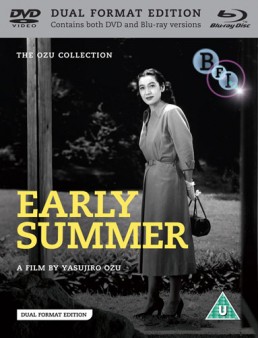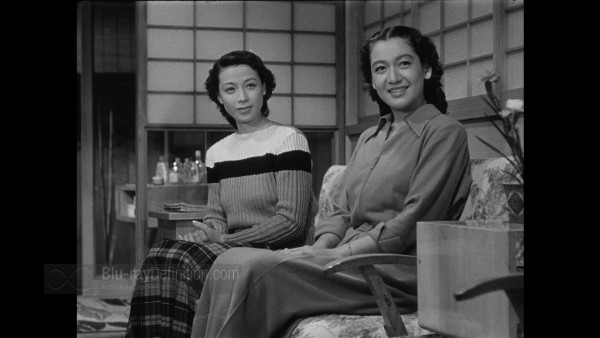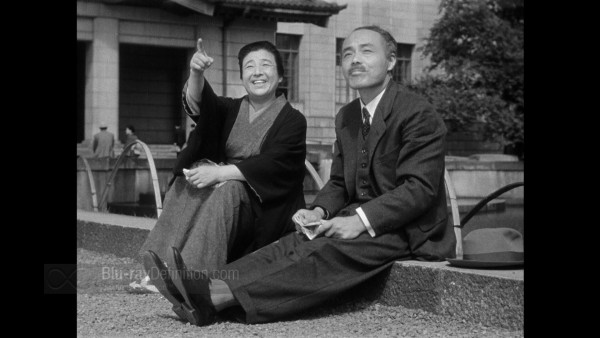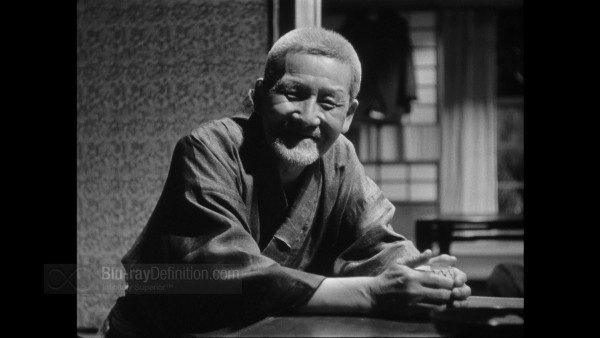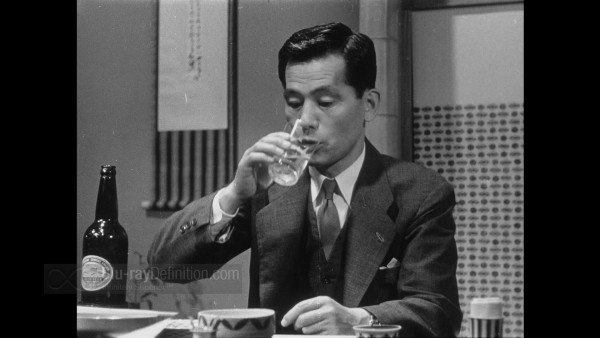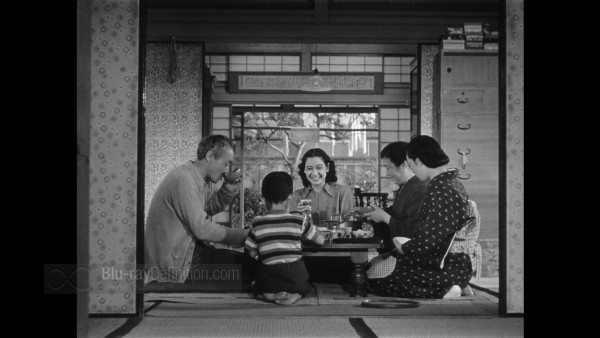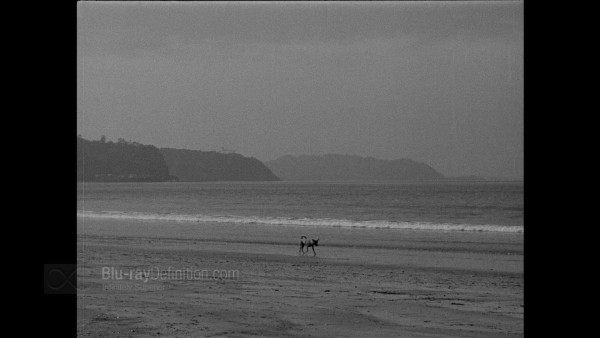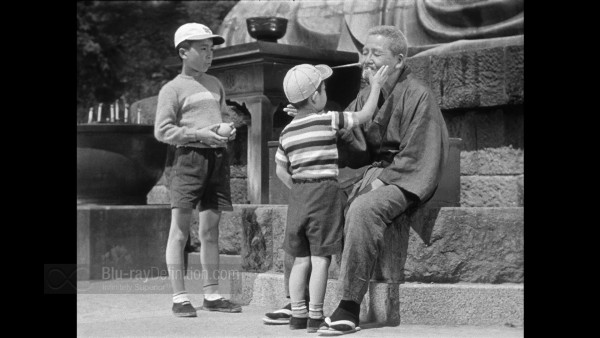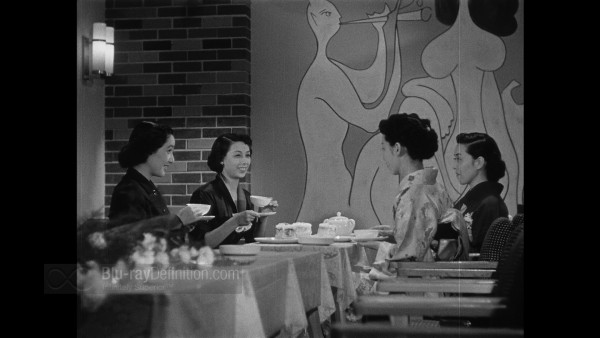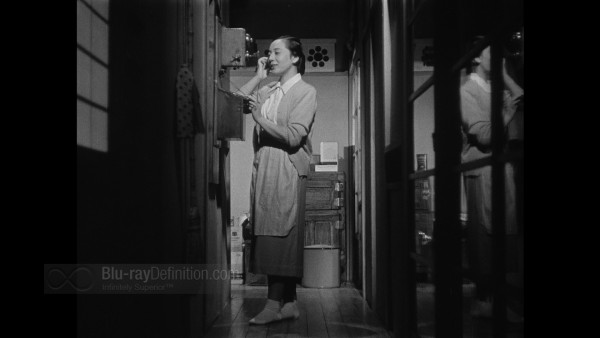- Aspect Ratio: 1.33:1
- Video Codec: AVC/MPEG-4
- Resolution: 1080p/24
- Audio Codec: Japanese LPCM 2.0 Mono (48kHz/16-bit)
- Subtitles: English
- Region: B (Region-Locked)
- Classification: U
- Discs: 2 (1x Blu-ray + 1 x DVD)
- Studio: BFI
- Blu-ray Release Date: July 19, 2010
- RRP: £19.99
[amazon-product align=”right” region=”uk” tracking_id=”bluraydefinit-21″]B0038409YM[/amazon-product]
Shop for more Blu-ray titles at Amazon.co.uk
Shop for more Blu-ray titles at Amazon.com
Overall
[Rating:3.5/5]
The Film
[Rating:4/5]
Video Quality
[Rating:4/5]
Audio Quality
[Rating:3.5/5]
Supplemental Materials
[Rating:2/5]
Click thumbnails for high-resolution 1920X1080p screen captures
(Screen captures are lightly compressed with lossy JPEG thus are meant as a general representation of the content and do not fully reveal the capabilities of the Blu-ray format)
The Film
[Rating:4/5]
Japanese filmmaker Yasujiro Ozu’s post-war films often concerned themselves heavily with the changing social structure of Japanese society — the differing roles women would take on in the culture, the shifting roles of the elderly, the new living conditions brought on by modernity. None of his films explored these themes more thoroughly and brilliantly, perhaps, than his early 50’s classics Tokyo Story, Early Summer, and Late Spring.
Ozu’s brilliance, however, was to turn his lens on the ever-changing society without ever really passing judgment on the new order of things. Ozu, rather, would craft a mere slice of life in film and through the evolution of a quiet story, show the changing state of Japan and the world at large. In this particular film, Early Summer, we are treated to one such classic Ozu moment in time, as one family’s central female character, Noriko (Ozu mainstay Setsuko Hara), having reached the age of twenty-eight, has come under pressure from her family members to marry. Noriko isn’t particularly keen on the idea, but she does also want to please her family, mainly her elderly parents and prying older brother.
Ozu uses several vehicles to juxtapose the modern and ancient in Early Summer, from the unruliness of Noriko’s bratty young nephews in comparison to their elderly relatives, to the mixture of lady friends, some married, some single, some in traditional Japanese garb and some in Western clothing.
Early Summer passes as easily and calmly as a quiet summer breeze, but at every turn it sparkles with deep thought and suppressed emotion bubbling under the surface.
Video Quality
[Rating:4/5]
Master elements for Early Summer were provided to the BFI by the Criterion Collection and the film appears here in a new high definition transfer its original 1.33:1 aspect ratio in an AVC/MPEG-4 1080p/24 encoding. While it is immediately obvious that the source is not in the greatest of conditions, the transfer provided here still yields satisfyingly film-like results with pretty strong details. Only sometimes do certain scenes give way to the elements, so to speak, and get lost in a shroud of softness and source damage. There are scratches and tramlines apparent throughout the presentation, but none of this is enough to hamper the overall solid effort that yields a strong black and white image with great contrast, stable greys and somewhat hefty looking blacks.
Audio Quality
[Rating:3.5/5]
Audio is provided in the original Japanese with a LPCM 2.0 monaural soundtrack. Hiss and crackle are a bit noticeable, but overall the sound is quite good for such an older recording and yields favorable results.
Supplemental Materials
[Rating:2/5]
In addition to bundling in the standard definition DVD in this Dual Format Edition release, the DVD also contains the biggest extra abhorring the collection and that is Ozu’s 1937 film, What Did the Lady Forget? (1937; 73-minutes; DVD-only), a rare comic pre-war feature, which plays with the themes of emasculation and feminine assertion.
- Booklet: The booklet features a brief yet informative essay by Michael Atkinson, writer for Sight & Sound, IFC.com, The Village Voice, and The L Magazine, on Early Summer and What Did the Lady Forget?, an Ozu biography by Tony Rayns and an essay on working with Ozu by Chisu Ryu.
The Definitive Word
Overall:
[Rating:3.5/5]
This is classic Ozu restored nicely in high definition by the BFI. One of the great Japanese filmmakers, the Ozu Collection rolls out with a strong set of films making a big argument for a new evaluation of these works.
Additional Screen Captures:
[amazon-product align=”right” region=”uk” tracking_id=”bluraydefinit-21″]B0038409YM[/amazon-product]
Shop for more Blu-ray titles at Amazon.co.uk
Shop for more Blu-ray titles at Amazon.com
Overall
[Rating:3.5/5]
The Film
[Rating:4/5]
Video Quality
[Rating:4/5]
Audio Quality
[Rating:3.5/5]
Supplemental Materials
[Rating:2/5]


